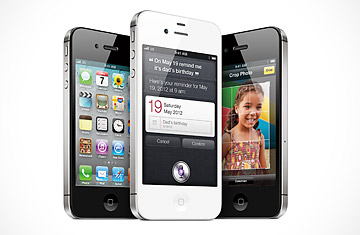
(2 of 2)
Then there's the 4S's display, which disappointed some folks by sticking with the 3.5-in. size of every previous iPhone. If Apple had enlarged it and simply made the pixels bigger, the screen would be grainier than that of the iPhone 4. Alternatively, the company could have rejiggered the phone's iOS software to accommodate extra real estate, as Google does with Android — but Android shows that this approach can leave software uglier and less easy to use. Odds are that there will be a bigger-screen iPhone some day, but not until Apple has figured out how to do it well.
Even the fact that the iPhone 4S body is a holdover from its predecessor has its benefits. For one thing, iPhone 4 owners who upgrade should be able to use the protective cases and other accessories they already own. For another, it allowed Apple to refine the body and antenna designs rather than starting from scratch. (The iPhone 4 reception problem known as antennagate — which was a real issue, though not remotely the catastrophe that some believed it to be — was a byproduct of the fact that the iPhone 4's body was so different from that of the 3GS.)
This isn't just an Apple thing. Microsoft Windows, one of the longest-running product lines in tech history, is an unending case study in the risk of sweeping change and the virtues of intelligent tweaks. Sweeping upgrades like Windows 3.0 and Windows 95 make most of the news; their follow-ups, including Windows 3.1 and Windows 98, simply work better. (Some of us still think that 1993's Windows 3.11 was one of the best operating systems ever — it had two full decimals points of perfection!)
Back in 2007, when Microsoft released Windows Vista, it quoted chairman Bill Gates as declaring it would "transform the way people work and play." It did — just not for the better. Vista started out as an ambitious effort to transcend Windows XP. But by the time Microsoft got it out the door, after multiple delays, it was — to borrow a memorable insult from Sun Microsystems founder Scott McNealy — a hair ball of a product. It worked poorly on both old PCs and on new ones that came with it preinstalled, and it refused to cooperate with printers and other devices that folks already owned. Consumers and businesses quickly decided to ignore it.
Less than three years later, Microsoft introduced Vista's successor, Windows 7. Most of its changes focused on removing Vista irritants and letting users get work done rather than babysitting their PCs. Even Steve Ballmer didn't claim it was a landmark product. It is, however, an extremely pleasant one — and a hit that quickly overcame Vista's bad reputation.
With next year's Windows 8, Microsoft is letting its imagination run wild again. The new version sports an all-new touch-screen interface, which acknowledges the iPad without ripping it off. If it works well, it could change the world forever.
I hope Windows 8 lives up to all of its considerable potential. But I'm already comfortable making this prediction: no matter how successful it is, its immediate successor — let's call it Windows 8.1 for now — will be both less daring and better thought out.
I'm already looking forward to that upgrade too — and if I end up comparing it to Windows 3.1, Windows 7, or even the iPhone 4S, I'll mean it as a compliment.
McCracken blogs about personal technology at Technologizer, which he founded in 2008 after nearly two decades as a tech journalist; on Twitter, he's @harrymccracken. His column, also called Technologizer, appears every Thursday on TIME.com.
Read more about the life and legacy of Steve Jobs in the tribute book from TIME, Steve Jobs: The Genius Who Changed Our World.
